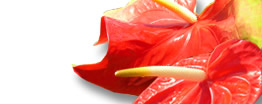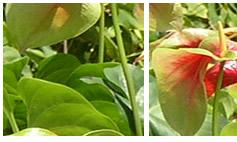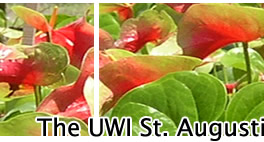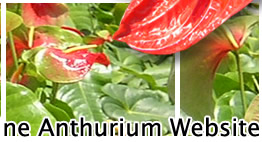|
Pest and diseases can totally debilitate an industry as has been experienced with the anthurium industry in the Caribbean and elsewhere in the world (See section on history of anthurium cultivation). Pest and disease management is hence one of the most important management practices carried out in an anthurium producing outfit, and can be the difference between whether an operation is profitable or not.
Anthurium in the Caribbean is grown commercially largely for the export market, which requires that the exported cut-flowers and foliage meet the phytosanitary regulations and guidelines of the importing countries. Cut-flowers of anthurium from the Caribbean usually target markets within the United States of America, which requires that anthurium plants be grown with minimal chemical applications and be certified as free of free of pests and diseases as well as chemical residue, based on standards issued by the USDA.
Prevention is the most important pest and disease management practice. There is no substitute for preventing pests and diseases from becoming established in a country or a production facility. Once a disease becomes established, it is usually time consuming and costly to eradicate. The first step of prevention therefore is an effective quarantine system at the national level. In addition, steps should be taken to prevent pests and diseases, already prevalent in a country gaining entry into the production facilities. The two major ways pathogens enter a facility are through plant material or by workers, visitors, implements or vectors.
It is therefore imperative that planting material that is brought into the nursery be certified free of pathogens. When purchasing plants from a supplier, ask a number of questions such as:
Have any diseases been observed in the material either in the tissue culture facility or the field?
Has the plant material been tested for the most common pathogens?
If the material has been produced in tissue culture, how long has it been deflasked? A lengthy time from deflasking to sale allows time for disease introductions. Before purchasing plant material, look around the supplier's nursery. Avoid suppliers who have facilities that are unkept. Look for weeds growing in or close to structures since many weeds can be alternate hosts for plant diseases or hosts of insects that can transfer pathogens to non-infected plants.
When plants are first brought into your facility, they should be quarantined in a separate greenhouse or, at least, at the end of a structure and down-wind of other plants. The quarantine period should be a minimum of three weeks, if possible, which is a standard time for diseases to appear. Keep in mind that many viruses, bacteria, and fungi can remain latent or not showing symptoms for months, and symptom expression can be subsequently triggered by environmental or nutritional changes to the plant.
Personnel are the second most common way pathogens enter a nursery. Pathogens can be carried on the shoes and/or clothing of workers. To kill many bacteria and fungal spores, workers can step on wet pads or in shallow troughs of dilutions of chlorine prior to entering a production area. In addition, workers should also be restricted in their movements around a nursery. Priority zones should be setup within the nursery, with propagation material separated from production areas. Only workers directly involved in propagation should be allowed in these areas, thus limiting inadvertent disease introductions.
Tools and equipment should be surface-sterilized between uses or between individual cuts if disease is present. This is especially important if tools and equipment are shared between production duties and grounds keeping. The need for managing disease can be reduced simply by preventing disease. Obtaining disease-free plant material, supervising workers closely, and practicing general sanitation of tools and equipment are some of the basic means to achieve this goal.
When a diseased plant is noticed it should be removed immediately and irradicated to prevent it from infecting other plants. If the disease has become established throughout the nursery, then removal of diseased leaves on a regular basis can reduce the inoculum and prevent the development of an epidemic.
Where prevention of disease introductions has failed, generally, chemicals may be used to control the various pest and diseases at an economic level. However, because of phytosanitary regulations in the import countries, there is a greater thrust at implementing integrated pest management measures to control pests and diseases. These include cultural, chemical and biological measures.
Cultural measures include pathogen exclusion, construction of traps, pruning, and burning of diseased plants or leaves in a safe location. This method should be the first one applied. It is usually the safest one but can require a lot of manual labour, hence making cultivation rather expensive.
Biological control involves the use of natural enemies of the pathogen which eat or kill the pathogen at certain stages of their life cycle or at all stages. Therefore, it is important to know and understand the pest, the stage (s) of its life cycle where it is problematic; know the natural enemies of the pest, their life cycles, and at what stage (s) in their life cycles would they antagonize the pest population. A lot of information on pests and their natural enemies can be obtained from the Ministry of Agriculture, and the departments of crop production and life sciences of the University of the West Indies, St. Augustine, Trinidad. It is important to note that biological control is ineffective against viruses and is of limited importance in bacterial diseases.
Some chemicals are specific to pest and diseases, while others are broad-spectrum in nature. Chemical control measures are usually the first choice by farmers, but they are increasingly becoming unpopular due to stringent import requirements and ineffective because of abuse and misuse of the chemical. Furthermore the newly developed ones are usually rather expensive, and can increase the cost of production and affect the profitability of the operation.
When chemicals are used to control diseases, it is important that the farmers use the correct chemical at the correct dosage (read the labels) and apply correctly as chemicals are expensive. If in doubt, apply chemical only on a small portion of the infected area to test its usefulness. The effectiveness of a chemical also varies with climate, weather conditions, soil and media conditions including pH, plant conditions (age, size, some chemicals are phytotoxic to anthurium plants) and method of application. Since chemicals are usually imported, a farmer should check with the authorities stated above to ascertain whether a particular chemical also affects the natural enemies of pests in a negative way, as natural enemies are important and are more long term pest controllers. Furthermore, when applying chemicals, it is important to always wear protective clothing and masks, as many chemicals can cause injury or death.
|




